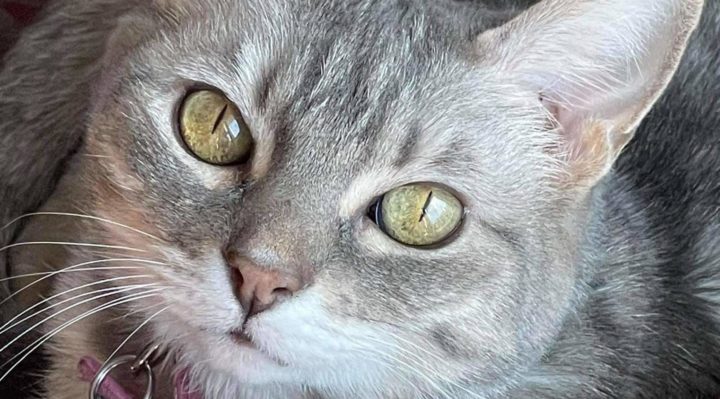
On the internet, so many cats and kittens, so much misinformation. It’s not their fault, our feline fellow citizens—we humans are the culprits in this crime. With good information, we can do better (so much better) for our cats and for ourselves. I don’t recommend online neighborhood groups as arbiters of what’s true and proven about cats, of course. How about advice instead from cat lovers with experience and education, successful trainers also of dogs, horses, birds, and other animals?
I asked these trainers the questions that I see throughout social media about the care, feeding, and training of pet cats. I kept in mind the stories that I read so often about cats who wake their humans up too early, cats that sleep on people even when it’s uncomfortable for the human, cats who search out and steal human food. Humans who live with cats may have many things they’d like to change about their cats’ behavior, but they rarely have a clear idea of where to start or how to do it positively.
Anna Abney (South Carolina) Teaching cats to recall [to come when called quickly and reliably] is easy as pie! Simply give whatever cue you want to use for the behavior and provide a yummy treat. Most cats are extremely food motivated and will come running. I’ve never had this method fail unless the cat in question happens to be deaf.
Don’t free-feed! Just like dogs, cats are built to consume meals rather than to graze. It’s healthier for them. They should also ideally be fed a wet diet, as cats don’t have a good thirst reflex and they need to get most of their moisture from their food.
Kittens should be raised with a variety of food types (dry, wet, raw, treats, and in a variety of forms and protein sources) to ensure they don’t become picky eaters as adults. Cats are imprint feeders rather than opportunistic like dogs, so if they don’t learn something is food when they’re young, they may never view it as food later.
Q: If cats imprint on “human food” as kittens (because they’re given it by humans or because they accidentally figure out how to “steal” it and find it rewarding), would that behavior get “stuck” in their repertoire, too? (I hear so many stories about food-stealing felines.)
Typically, yes. And cats are inherently more independent and more stealthy than dogs, so food thieving is a bit harder to manage. However, I have succeeded in teaching all of my cats not to steal from me directly, so I can eat without feline harassment. Mostly, I just block them physically until their efforts extinguish. I do have the benefit of a little black herd dog who enforces my edicts.
My cats are all crate-trained. This allows me to closely monitor food intake and to prevent food fights or bullying. It also means that, if a cat is being a pest (young cats in particular tend to get loudly boisterous in the wee hours when the humans would like to sleep!), I can send her to her crate to stop her from running across my face in bed or from swatting something noisy around. I crate-train cats the same way I crate-train dogs: by feeding them their meals in the crate and releasing them at some varying length of time after they have been calm and quiet for a while. I have a brand-new cat now that I’ve had less than two weeks. She already goes to her crate of her own volition at mealtime or when I point at the crate (and she is deaf!).
Tiffany Copley (Ohio) Yes! I crate my kittens like I do puppies! Keeps them out of trouble and keeps my toes safe at night!

Photo by Ann Marie Danimus
Sonia Fetherling (Illinois)
■ Give them high places to climb (cat trees, shelves, etc.).
■ Give them multiple types of scratching posts, different textures, materials, and positioning.
■ Try different litters, multiple boxes (best are usually uncovered), ensure that litter is deep enough, scoop once or more times daily!
■ Play with your cat and provide different types of enrichment (poles with toys on end to catch, filled kitty Kongs, etc.
■ Avoid light/laser chasers—they can be very arousing yet frustrating for cats. They never catch their prey. If you are going to use one, when they pounce on it, place a treat down by their feet for them to have “caught” and which they can now consume. This meets their needs as predators.
Micha Michiewicz (Maryland)
■ Enrichment for meals, exercise and hunting-behavior substitution is a key component to safely meeting their species needs. This can be positive training sessions, foraging toys, flirt poles, scents placed around the home, a window perch to watch a bird feeder out a window, and anything that enriches their day.
■ Early kittenhood positive socialization is important for helping to create a well-rounded, more confident adult cat.
■ Inappropriate eliminating outside of the litter box often indicates stress, which may be emotional or medical. A vet visit is the first step in ruling out any medical causes.
■ Claw removal frequently results in a painful paw experience with litter boxes and with early arthritis, and it is not recommended.
■ Don’t wait to hire a qualified positive trainer to address issues and to help to train more acceptable behavior for a safe and more conflict-free coexistence.
Gwen Jones (California)
■ The trick to training cats is not to try to do too much at once. Their attention spans won’t tolerate a long training session. Use a variety of treats so they won’t get bored.
■ Mitigating unwanted behavior is more difficult, and requires a lot of “out of the box” solutions—unless, of course your cat’s problem is that they’re going “out of the box,” because for that you need “in the box” solutions.
■ Cat scratching the furniture? Using double-sided tape can be a deterrent, but doesn’t really train them not to do it. Double-sided tape along with placing an appropriate scratching post in front of, or next to, the preferred scratching area can help train them to use the correct piece of furniture.
■ Be creative with where you put cat furniture to entice the cat to use it properly. Cats love to watch the world go by—they would prefer a window seat.
■ Playing with and exercising your cat is extremely important for indoor-only cats. Again, a variety of toys is helpful at keeping their interest piqued. I wish everyone could/would keep their cats indoors, but I believe a lot of misbehavior from cats is a result of their lack of physical exercise and stimulation. Playing hunting and chasing games with them really does help mitigate a lot of bad behaviors, including the late-night wake-ups.
Colleen McCarvill CPDT-KA (Alberta, Canada) Cats that are free-fed, even kibble, are a little less likely to be motivated by treats, but it’s never impossible. I’ve worked with cats that are not as food motivated but that enjoy certain kinds of toys. There is always something to motivate an animal. We just have to look hard enough.
For one little cat I worked with, there didn’t appear to be anything motivating until I crushed up a little piece of paper, and bingo—currency for everything from recall to complex tricks. (This was a therapy cat in training.) I find cats as easy to work with as dogs. Of course, not as many owners are looking for behavioral or training advice for cats, but every animal has a currency. If you ask enough questions, you will find that currency.
Terrie Hayward (British Virgin Islands) Cat sleeps/lies on the human, even when it’s uncomfortable for the human? Put a towel on the bed. Lie on it with your cat. Then after a day or so, place the towel over the cat’s bed. Encourage/put the cat on the bed—voilà. Smells like you+the cat = cat loves new cozy spot. Also known as “make incompatible behavior reinforcing!”
Rebecca Cook (Washington) As with most humans, cats’ bad behaviors tend to arise from insecurities. If a new behavior develops, you have to see what has changed to cause that behavior. What is threatening their security? A new pet in the house, a new cat outside sniffing around, someone’s having left the house, injury, or illness? A traumatic event like getting locked in a closet or being stepped on? There are a million possibilities, but cats get really funny when they’re hurting. It can be as simple as adding a high place for them to feel safe looking down, or adding an extra exit for them from tight rooms.
Cheri Spaulding (Oregon) My dog brought home a cat from a nearby barn. They were in love, but when my dog died, her cat, Rusty Nail, was grieving. I didn’t have any relationship with Rusty Nail before all this happened. I fed him and took him to the vet when he needed to go, but otherwise he hung out with Martha, his dog. Rusty started attacking me. A vet suggested I euthanize him but I could not do that because he was my dog’s cat. I started keeping little cat toys around the house. When I saw him coming at me, I would throw the toys away from me. I found a cat treat he liked—little dehydrated salmon bits—that would divert his attention and, very soon, I had taught him to fetch, rewarding him with the salmon bits when he brought the toy to me. Now he loves training and we have built a relationship.
Jessica Theisen de Gonzalez (New York) Minzen’s behavior continues to evolve. I got him as a foster last July from the Brooklyn branch of the Animal Care Centers of NYC and I adopted him a few months later because I was so moved by how anxious and shut down he was. He purred this week for the fourth time this year, and he has cautiously begun to rub himself against my legs in greeting.
The biggest cat behavior tip is to follow their lead, with patience and steady positive responses to their changes. All of the progress that Minzen made took months. Fortunately, he’s very food motivated so crate-training him was a breeze, which makes transport to a vet so much simpler! No more canceled appointments because the cat took off and hid! (Ask me how I know.) He’s even learned how to spin in a circle for a treat. Minzen came a long way from the wide-eyed cat who sat for hours in an open carrier, in a locked bathroom, too frightened to move.
I’m really wishing that crate-training cats will become normalized. It’s such a huge help in so many ways.
What behaviors about your cat or cats would you like to change?
Where would you start to change the behavior?
Write out all the steps in a simple training plan.
Remember the LIMA guidelines—Least Intrusive, Minimally Aversive.
Summer Storm Kingery DVM (North Carolina) recommends the many resources available at this website:
Cat Behavior Associates
https://catbehaviorassociates.com



